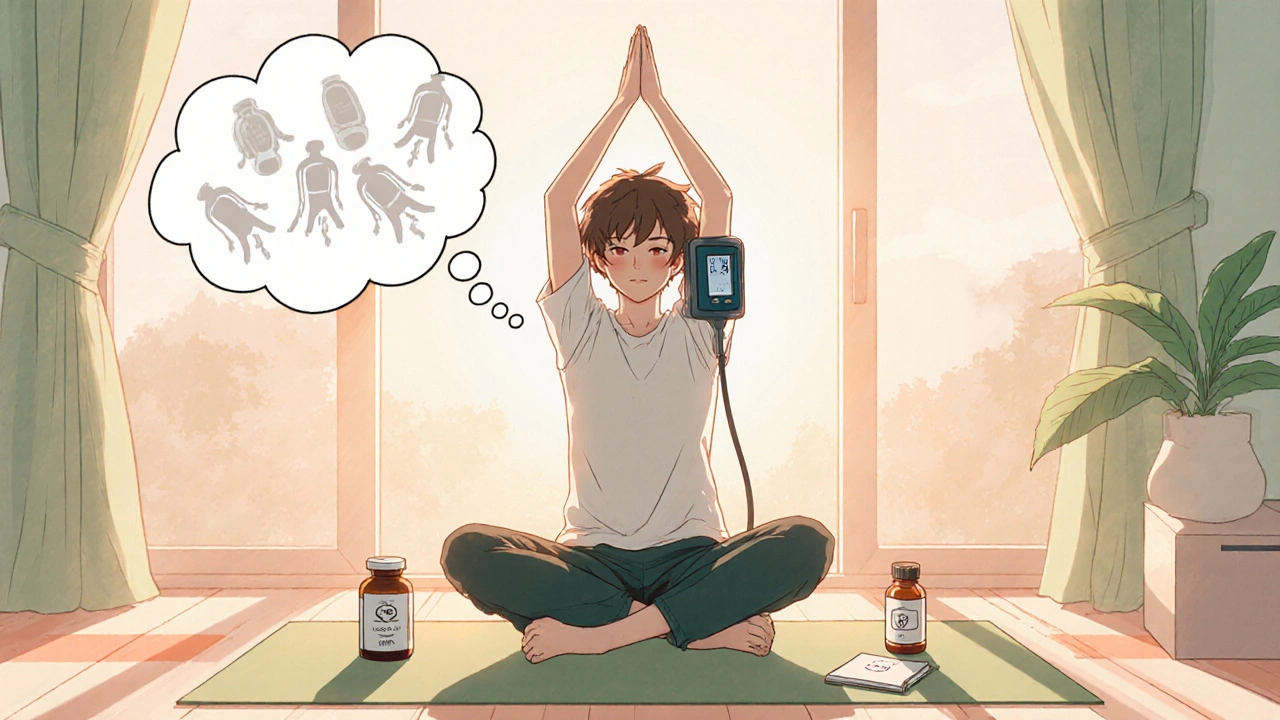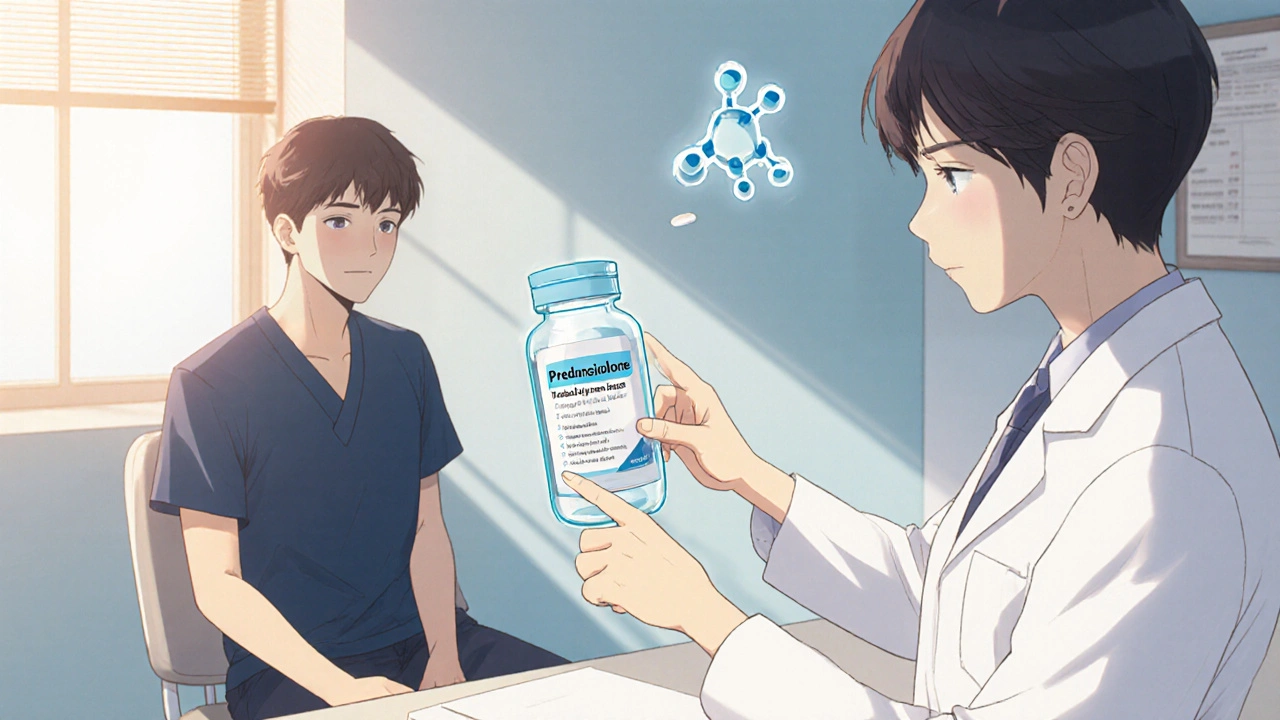Steroid Dose Converter
Steroid Dose Conversion Tool
Convert between different corticosteroids using the potency ratios from clinical studies. Enter a dose in one steroid and find its equivalent in others.
Equivalent Doses
The doses below represent the equivalent anti-inflammatory activity. Always consult your healthcare provider before making dose adjustments.
| Alternative Steroid | Equivalent Dose (mg) | Potency Level |
|---|
Important Note: This tool provides approximate conversions based on clinical studies. Individual patient response varies and may require dose adjustment by a healthcare professional.
If you’ve ever been prescribed prednisolone, you might wonder how it stacks up against other steroids. This guide walks through the most common alternatives, highlights key differences, and gives practical tips for choosing the right anti‑inflammatory medication.
What Is Prednisolone?
Prednisolone is a synthetic glucocorticoid used to reduce inflammation and suppress immune responses. It was first approved by the FDA in the 1950s and remains a go‑to option for conditions like asthma, rheumatoid arthritis, and eczema. The drug works by binding to glucocorticoid receptors, altering gene expression, and ultimately dampening the production of inflammatory cytokines.
Typical oral doses range from 5 mg for mild dermatitis to 60 mg for severe systemic flare‑ups. Its half‑life sits around 2‑3 hours, but the biological effects can linger for much longer because of gene‑level changes.
Why Compare Alternatives?
Even though prednisolone is effective, every corticosteroid brings its own potency, duration, and side‑effect profile. Some patients need a longer‑acting agent, others a weaker steroid to avoid complications like bone loss. Comparing alternatives helps clinicians and patients balance therapeutic goals with safety.
Top Oral Corticosteroid Alternatives
- Dexamethasone is a highly potent, long‑acting glucocorticoid. It’s often used in oncology and severe allergic reactions.
- Methylprednisolone is a medium‑potency oral steroid that offers a smoother tapering curve than prednisolone.
- Hydrocortisone is the least potent glucocorticoid in oral form, closely mirroring the body’s natural cortisol.
- Budesonide is a locally acting steroid with high first‑pass metabolism, reducing systemic exposure.
- Betamethasone is a very potent, long‑acting steroid often reserved for dermatologic conditions.

Side‑Effect Landscape Across Steroids
All oral glucocorticoids share a core set of risks: hyperglycemia, hypertension, mood swings, and increased infection susceptibility. However, potency and duration magnify these effects. For example, dexamethasone’s strong anti‑inflammatory power makes adrenal suppression a bigger concern, while hydrocortisone’s milder action usually translates to lower bone‑loss risk.
Head‑to‑Head Comparison
| Drug | Relative Potency* (to hydrocortisone) | Half‑Life (hrs) | Typical Oral Dose Range | Major Side‑Effect Concerns |
|---|---|---|---|---|
| Prednisolone | 4‑5 | 2‑3 | 5‑60 mg | Osteoporosis, glucose intolerance |
| Dexamethasone | 25‑30 | 36‑54 | 0.5‑9 mg | Severe adrenal suppression, psychiatric effects |
| Methylprednisolone | 5‑6 | 2‑3 | 4‑48 mg | Similar to prednisolone but smoother taper |
| Hydrocortisone | 1 (reference) | 1.5‑2 | 10‑30 mg | Higher daily dosing needed, less bone loss |
| Budesonide | ≈2‑3 (systemic) | 2‑3 | 3‑6 mg | Minimal systemic side‑effects due to high first‑pass metabolism |
| Betamethasone | 20‑25 | 36‑54 | 0.5‑4 mg | Strong adrenal impact, skin thinning when used topically |
*Potency values are rough equivalents based on anti‑inflammatory activity compared with hydrocortisone.
Decision Criteria: How to Pick the Right Steroid
- Intensity of inflammation: Severe, rapid‑onset flare‑ups often call for dexamethasone or betamethasone because of their high potency.
- Duration needed: If you need a short burst, hydrocortisone or budesonide work well; for prolonged control, prednisolone or methylprednisolone are smoother.
- Underlying health conditions: Diabetes, osteoporosis, or psychiatric history tip the scale toward weaker steroids or those with limited systemic exposure, like budesonide.
- Route of administration: Budesonide’s high first‑pass effect makes it ideal for oral use when you want a primarily local lung effect; otherwise, oral tablets of prednisolone dominate.
- Cost and insurance coverage: Generic prednisolone and hydrocortisone are usually the cheapest; newer agents may need prior authorization.

Managing Common Side Effects
Regardless of the steroid you choose, a few proactive steps can blunt unwanted outcomes:
- Bone health: Calcium (1,200 mg) and vitamin D (800‑1,000 IU) daily, plus weight‑bearing exercise, can offset steroid‑induced bone loss.
- Blood sugar: Monitor fasting glucose weekly if you have diabetes; adjust oral hypoglycemics under medical guidance.
- Blood pressure: Reduce sodium intake and keep an eye on home BP readings, especially with higher‑potency steroids.
- Mood swings: Keep a symptom diary; discuss any irritability or insomnia with your prescriber early.
- Tapering: Never stop abruptly. A typical taper reduces the dose by 10‑20 % every 3‑7 days, depending on the duration of therapy.
Frequently Asked Questions
Frequently Asked Questions
Can I switch from prednisolone to a milder steroid without a doctor?
No. Switching changes the dose‑response curve and can trigger adrenal insufficiency if not tapered properly. Always coordinate with a clinician.
Is budesonide truly “steroid‑sparing”?
Budesonide’s high first‑pass metabolism means less drug reaches systemic circulation, so it causes fewer classic steroid side effects. It’s a good option for mild‑to‑moderate asthma.
What’s the biggest risk of long‑term dexamethasone use?
Severe adrenal suppression, which can lead to life‑threatening Addisonian crises if the drug is abruptly stopped. Monitoring cortisol levels is essential.
Do I need calcium supplements on prednisolone?
Most experts recommend calcium and vitamin D for anyone on a prednisone or prednisolone course longer than three weeks, especially in post‑menopausal women.
How fast does prednisolone start working?
Patients typically notice symptom relief within 4‑6 hours of the first dose, although full anti‑inflammatory effect may take 24‑48 hours.
Choosing the right steroid is rarely a one‑size‑fits‑all decision. By weighing potency, duration, side‑effect profile, and personal health factors, you can partner with your doctor to find the safest, most effective option for your condition.

Joe Moore
October 18, 2025 AT 17:06Yo, have you ever noticed how pharma pushes prednisolone like a brick to keep us hooked while they hide the real, safer alternatives? They don't want you reading the fine print about budesonide's low systemic exposure, because that would cut their profits.
Wake up, folks, it's all a controlled narrative.
Emma Williams
October 21, 2025 AT 00:40Great overview thanks
Drew Waggoner
October 23, 2025 AT 08:13Reading through this guide feels like a tidal wave of info that just keeps sucking my energy, but I’ll admit the breakdown of side‑effects was oddly comforting.
Even the tables gave me a strange sense of calm amid the steroid storm.
Norman Adams
October 25, 2025 AT 15:46Oh sure, because the only thing standing between us and eternal health is a shadowy cabal of pill‑peddlers – never mind the decades of clinical trials that actually guide prednisolone use.
Margaret pope
October 27, 2025 AT 22:20Look, the key is matching the steroid strength to the inflammation level and your personal risk factors – don’t forget calcium and vitamin D if you’re on a longer course
Karla Johnson
October 30, 2025 AT 05:53When choosing between prednisolone and its cousins you first have to understand the concept of glucocorticoid potency. Potency determines how much drug is needed to achieve the same anti‑inflammatory effect, which in turn influences the side‑effect burden. Prednisolone sits in the middle of the spectrum, more powerful than hydrocortisone but less intense than dexamethasone or betamethasone. This middle ground makes it a versatile option for many chronic conditions such as rheumatoid arthritis, COPD exacerbations, and severe eczema. However, the pharmacokinetics of prednisolone, with a half‑life of roughly two to three hours, mean that its biological effects linger far beyond the plasma clearance because gene transcription is altered. For patients who need a rapid taper, methylprednisolone often provides a smoother curve thanks to its slightly longer duration of action. On the other hand, if the therapeutic goal is to minimize systemic exposure, budesonide’s high first‑pass metabolism makes it an attractive choice for localized lung disease. Dexamethasone, with its impressive potency of twenty‑plus times hydrocortisone, is reserved for life‑threatening allergic reactions or oncologic protocols, but it carries a heavy risk of adrenal suppression. Betamethasone, similarly potent, is frequently used in dermatology because its long action allows intermittent dosing. Hydrocortisone, the weakest of the lot, is useful when you want to mimic the body’s natural cortisol rhythm, especially in adrenal insufficiency replacement. When weighing side effects, bone health remains a top concern; prednisolone can accelerate osteoporosis if used longer than a few weeks without prophylaxis. Calcium and vitamin D supplementation, coupled with weight‑bearing exercise, are evidence‑based strategies to blunt that risk. Blood sugar spikes are another common issue, particularly in patients with pre‑existing diabetes, and regular glucose monitoring can catch problems early. Blood pressure should also be watched, as steroids can promote sodium retention and vascular resistance. Mood changes, while often under‑discussed, can range from mild irritability to frank psychosis, so a symptom diary is advisable. Ultimately, the decision rests on a balance of disease severity, comorbidities, cost, and patient preference, and it should always be made in partnership with a knowledgeable clinician.
Linda A
November 1, 2025 AT 13:26The cascade of hormonal whispers that prednisolone unleashes reads like a modern tragedy, each sentence a reminder of the delicate dance between cure and collateral damage.
Ayla Stewart
November 3, 2025 AT 21:00It's helpful to remember that the choice of steroid often depends on how quickly you need relief and how long you plan to stay on the medication.
Poornima Ganesan
November 6, 2025 AT 04:33While your summary is neat, it glosses over the fact that many clinicians still default to prednisolone out of habit, ignoring newer agents like budesonide that clearly reduce systemic burden for asthmatic patients.
Stephanie Zaragoza
November 8, 2025 AT 12:06Indeed, the pharmacodynamic profile of each glucocorticoid-potency, half‑life, receptor affinity-must be meticulously matched to the patient’s clinical picture, otherwise the therapeutic window narrows dramatically, increasing the likelihood of adverse events, particularly osteopenia, hyperglycemia, and mood disturbances.
James Mali
November 10, 2025 AT 19:40Just another reminder that steroids are a double‑edged sword 🗡️, wield them wisely.
Tracy O'Keeffe
November 13, 2025 AT 03:13Oh, the melodrama of a blade in the night! Yet, dear observer, you capture the essence of our hormonal theatre with such poetic flair.
Rajesh Singh
November 15, 2025 AT 10:46We must hold ourselves accountable for prescribing powerful steroids only when absolutely necessary, because every unnecessary course chips away at the fabric of public health.
Albert Fernàndez Chacón
November 17, 2025 AT 18:20Sounds like a solid plan, just remember to keep an eye on the basics-diet, exercise, and regular check‑ups-to stay ahead of any side effects.